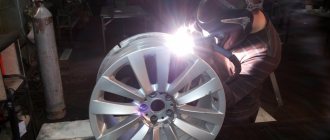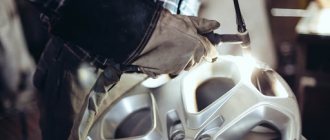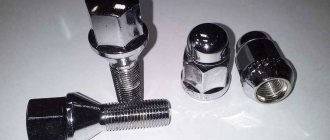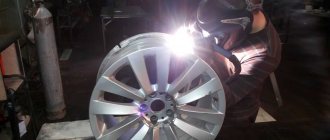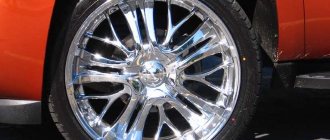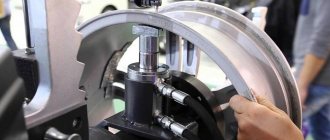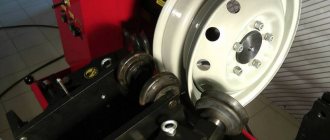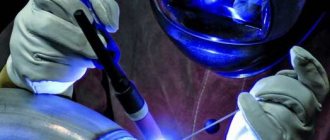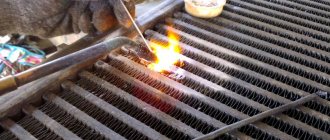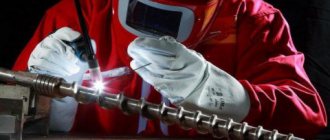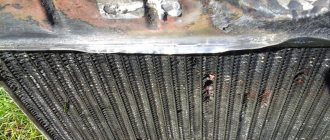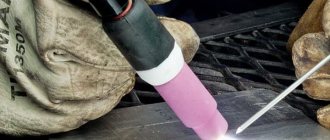Alloy wheels confidently occupy a leading position among most car enthusiasts. Compared to conventional stamped wheels, casting is much stronger and more beautiful. But due to poor quality roads, small stones and debris flying from the side of the road, the discs can become deformed. In most cases, the car owner gets a crack or chip, and in the worst case, the disc becomes jammed and requires serious repairs.
Welding of cast car wheels is one of the most popular services among servicemen. Often, car owners are offered argon welding of discs as the highest quality and at the same time inexpensive. Additionally, the car owner may need to straighten alloy wheels; here, too, welding is indispensable. In this article we will briefly describe what features alloy wheels have and how to repair them yourself.
Types of disks
The disc is the part of the wheel on which the rubber tire fits. Discs can be made from different materials and using different technologies, which will determine their properties. The most common are stamped discs, for the manufacture of which carbon steel is used.
They are made of two parts - the central one and the rim, which are then combined with each other by welding. After joining, the discs are coated with enamel to protect them from environmental influences. This is a budget option, since the cost of stamped discs is not too high, although they are not particularly beautiful. Stamped wheels are installed on new cars coming out of production, which reduces their cost.
Due to the fact that materials that provide softness and plasticity are used in the manufacture of stamped disks, they can be classified as products with high maintainability. When operating a car, this becomes a significant advantage.
When mechanical shocks occur, the disk is crushed and its shape changes. At the same time, he absorbs the main part of the blow, partially dampening it. The modified disk is subject to restoration, in particular, repair of disks by welding is used. The disadvantage of stamped discs is their heavy weight. This can lead to poor performance and increased gas mileage.
Alloy wheels are a single piece made by casting. Aluminum-based alloys are mainly used for their manufacture. Steel is unsuitable for this. In order for cast wheels to gain greater strength, they are subjected to hardening, which relieves residual stress. After this, the discs are varnished.
The big advantage of alloy wheels is their low weight. As a result, the load on the vehicle's suspension is reduced, which increases its stability and ease of control. The suspension wears out less. Due to the reduction in shocks, the ride comfort in such a car increases. Due to the fact that there are no caps in the internal part, the brake system can cool naturally. The use of aluminum provides increased corrosion resistance. In this way, the initial costs are compensated.
However, the strength obtained during hardening leads to fragility of the product. If the car receives an impact, the alloy wheel will not bend, but will crack or split. In this case, alloy wheels will need to be repaired by welding.
Forged wheels differ from cast wheels in their manufacturing technology.
The material for them is light aluminum alloys with the addition of magnesium. The manufacturing technology is hot stamping. The resulting blanks are then machined to achieve the desired design.
The beauty of forged wheels is combined with lightness and strength. An important quality is plasticity. If the machine receives a strong blow, the forged disc will not crack, but will become crumpled. This will ensure the possibility of its restoration, which will be ensured by welding forged wheels.
The procedure for carrying out repair work
To correct damage to alloy wheels, it is necessary to involve specialists who repair them. In addition, specialized equipment and tools will be in demand. So, you can only restore the protective coating with your own hands.
In the repair shop, approximately the following list of work will be done.
Preparation - any disk must undergo an inspection before starting work. To perform this operation, it must be cleaned of dirt and only then will all damage become noticeable.
If cracks are detected, the disc will have to be sent for welding. Welding of cast wheels is performed using equipment that allows work to be performed under the protection of inert gases. To repair discs made of aluminum, electrodes of the AG brand are used; for discs made of magnesium alloys, it is necessary to use electrodes of the AMG brand.
After all the cracks have been welded, the surface of the disk must be cleaned of welding marks. If necessary, special equipment must be used.
After cleaning the disk, its geometric parameters are checked. To do this, the finished disk is installed in a special cartridge. To restore geometric parameters, a hydraulic cylinder equipped with special attachments is used. In this way, beats and, of course, geometric parameters are eliminated.
After the defects have been eliminated, the disc will be sanded, degreased and sent for painting. Coatings that are based on epoxy resin are often used for coating.
The very last operation is balancing.
Types of damage
If you compare different types of disks, you will notice that forged disks are characterized by high fragility, while cast and stamped ones bend easily. Depending on this, various methods of their restoration are required.
Welding of discs becomes necessary in case of the following damage:
- chips;
- rim curvature;
- offset relative to the axis;
- missing some parts;
- faults;
- cracks;
- scratches;
- bullies;
- surface damage.
These damages can be corrected, with the exception of cracks on the hub, as well as critical deviations from the geometry. To correct damage, welding of disks with argon is used. It is especially advisable to use this method when cracks and chips form. Straightening of cast wheels by welding is carried out using this method.
Surface preparation
Argon welding of cast wheels begins with surface preparation. If you only need to weld the crack, then you will have to widen it somewhat and remove paint from the surface of the cast disk to a distance of at least 1 cm from the crack on both sides.
If the disk has a chip (and this happens more often than a crack), then you will have to work on the disk itself and the piece that you would like to weld. It will work out well if it is part of the disk itself. In the case of using a “donor” part from another disk, it is recommended to double-check the compositions of the surfaces being welded.
Torch diagram for argon welding.
The same rules apply here: the slightest deviation from the composition of the product - and all your work will be in vain. It is not difficult to adjust the borrowed piece to the size of the existing chip in the wheel rim: glue a sheet of paper to the damaged part and trace the boundaries of the chip with a pencil. Next, the paper is transferred to the “donor” disk, and along the resulting lines the contour is transferred to the surface. Along these lines you will have to cut the patch.
The parts are cleaned of irregularities at the chip site, and the welding area is cleared of paint at a distance of at least 1 cm. This is done using a grinder. It is quite difficult to remove paint from a product in any other way, since this paint has a very specific composition and adheres to the surface just fine. When welding, the paint will burn and produce large amounts of acrid smoke. For this reason, welding of wheel rims is carried out in a ventilated area or in the presence of a good exhaust hood.
If you do not have experience in welding, then you should not proceed directly to repairs. It is necessary to acquire at least the slightest skills and only after that try to do something. You can test the welding machine in operation and acquire skills in working with it on any aluminum parts. It is advisable that this process take place in the presence of a more experienced master.
Repair by argon welding
Repairing discs by argon welding is the most effective method, which is why it is most widespread. Although this gas is included in the name of the method, it does not take part in the direct connection of metal parts. Its function is to create a protective environment that allows successful welding of various metals.
The main property of argon is that it is heavier than air, due to which it is able to displace its other volatile compounds from the weld pool. Argon, like all inert gases, does not react with other chemical compounds. It does not affect the welding process. Argon has one feature - when reverse polarity is turned on, it begins to play the role of an electrically conductive medium. Welding of car wheels with argon can be carried out manually, semi-automatically and automatically.
The advantage of the argon welding method also lies in the absence of preliminary preparation of the product, with the exception of cleaning it from contaminants. Thanks to the protective argon environment, the formation of an oxide film does not occur. Welding cast wheels with argon allows you to eliminate defects in hard-to-reach places.
Argon welding of discs will require the following equipment:
- A welding machine with an alternating current welding function. Inverters have an advantage.
- Filler rods.
- Burner.
- Tungsten electrodes.
- Argon cylinder.
- Rectifier.
- Transformer.
- Oscillator.
Welding of light alloy wheels will be achieved using non-consumable tungsten electrodes.
Small impurities of other metals are acceptable, which improves the quality of the electrode. Such electrodes are called non-consumable because their size practically does not decrease during welding. Welding aluminum wheels with tungsten electrodes will ensure a good result. Don't forget about personal protective equipment. These include a thick suit, sturdy shoes, canvas gloves and a welding mask.
Foreign regulatory documents
Wheel rims are highly loaded elements of a car, on which its safety largely depends. Therefore, leading manufacturers of cars and wheel rims do not allow any repair work to be performed on them, including repair welding.
The ISO 14400 standard explicitly states that repairs to wheel rims by welding should not be carried out, as this may introduce additional stresses into critical areas [1]. The organization EUWA (Association of European Wheel Manufactures) - the Association of European Wheel Manufacturers - strictly prohibits the repair of damaged rims and disks of automobile wheels using heating, welding or adding any additional material [4].
At the same time, the regional regulatory document of the Canadian province of British Columbia - rules for welding repair of aluminum wheel rims - allows for the limited use of welding for the repair of wheel rims [5].
Welding technology
Repairing cast wheels by argon welding requires a preliminary determination of the chemical composition of the base material, since the metal patches must match it for good weldability and have approximately the same characteristics. It is possible to join only homogeneous metals.
Depending on the degree of damage, the appropriate power is set on the equipment. If the metal thickness is less than three millimeters, then preliminary cutting of the edges is not required. Welding of cast disks should be carried out at increased speed, which will minimize the thermal effect on the metal being processed. For better arc ignition, the electrodes should be preheated.
Maintaining the arc length in the range of 1-1.5 millimeters will contribute to the destruction of the oxide film on the surface, which is necessary to obtain a high-quality weld. To avoid damaging the shielding gas cloud, the welder must guide the electrode smoothly, avoiding oscillatory movements. Uniform supply of filler material will be ensured when using semi-automatic equipment.
To free metal from dirt, mechanical methods will be required, and from fats, oils, and paint - chemical methods. When metal patches are used to remove defects, they must first be tacked to ensure fixation, after which you can begin to weld the seams. To weld aluminum disks, reverse polarity is used.
If sections of significant thickness are to be welded, the welding site must be preheated to avoid the appearance of cracks in the metal. A torch or cutter is used for this.
Repairing disks using the welding method should begin by setting the current to 150 Amperes. It is recommended to carry out welding in two passes, first welding the root of the seam, and then filling the joint. You can also use a torch to go over the underside of the seam to even it out.
If it is necessary to surfacing the missing part, then a small current is set, about 120-140 Amperes. The extension should be carried out in several layers, removing the excess by grinding after welding. If a crack is welded, then it is necessary to ensure that the weld metal covers the sides with a margin. If, after cleaning the seam, there are unfused areas, you should go over the seam again and then clean it.
Argon should be supplied to the work area a few seconds before welding begins. For an arc to occur, the torch must be located close to the surface of the disk. It is not recommended to feed filler wire too quickly to avoid causing excessive spatter. The wire should be placed slightly in front of the burner. The arc should be as short as possible. The optimal distance between the surface of the disk and the end of the electrode is one and a half millimeters.
The weld crater is welded without interrupting the arc, by gradually reducing the voltage. The supply of argon is stopped only a few seconds after the completion of welding of the disk. In addition to repairing these car parts, motorcycle rims can be welded in the same way.
Welding tips
Experienced welders give the following advice when carrying out work:
- To prevent abrasive from getting into the seam, it is advisable to cut the part with a milling cutter.
- If you cannot weld the crack in one approach, then you need to cut out the root of the seam from the back side.
- It is better to place copper or stainless steel linings on the reverse side.
- In order to reduce the stress on the part, it is necessary to heat the welded area to approximately 250-300 degrees . Laundry soap will help determine the temperature. To do this, you need to run a bar of soap over the disk and heat it. When the mark turns brown, the temperature on the disk is 250 degrees , and when it turns black, it is 300 degrees .
The procedure for performing welding work
Modes when performing welding work.
So, you have prepared the surfaces, have some experience with argon welding and can get to work. Initially, the welding site is heated with a torch. We make sure that the metal does not overheat. When a certain color appears (depending on the material of the product), an electrode is brought to the seam. If all the rules are followed, the metal from the electrode will quickly melt and fill the seam.
If you are welding a chip on a wheel rim, it is advisable to “grab” it along the edges to give the patch its final position, and then you can weld along the entire length of the fracture. When welding correctly, the seam should be visible on both sides (the molten metal should fill the entire space and enter the structural metal lattice of the disk).
If the thickness of the disk is large, then it is better to carry out welding in several stages on both sides, placing the seams on top of each other. It will be much more reliable. After the disc has completely cooled (remission), the seam must be sanded and prepared for painting. And here the same grinder with a sharpening and grinding attachment will help you. After surface treatment, the restored cast disc is ready for use.
Painting
The final stage of making a welding joint with your own hands is painting the disc. The powder composition is considered to be the best for painting. Of course, before you start painting, you need to clean the disc and degrease its surface. After that you need to apply a primer, and only after that start applying paint. It is best to apply several layers of paint. Now you should wait until the paint is completely dry and apply a protective varnish. This way the coating will last a long time
It is important to roll the rims before painting and eliminate runout.
On the one hand, making welding with your own hands seems as easy as shelling pears and any car owner without any engineering skills can handle it. But if you look from the other side, this is a change in the factory settings of the car’s suspension. Of course, you need to do balancing after the wide rims are fully installed, but this will not change the accelerated wear of the car.
Opinions regarding the use of welds are divided into categorical “against” and the same categorical “for”. Those who are “against” believe that welding joints lose reliability, maneuverability and increase fuel consumption and the load on the vehicle’s chassis. But those who are in favor insist that this type of disc was not so long ago used for tuning racing cars, so it cannot be unreliable and unsafe. One way or another, until you try it yourself, you probably won’t be able to find out who is right. One thing can be stated unequivocally: the main thing is to do everything wisely and “conscientiously.”
